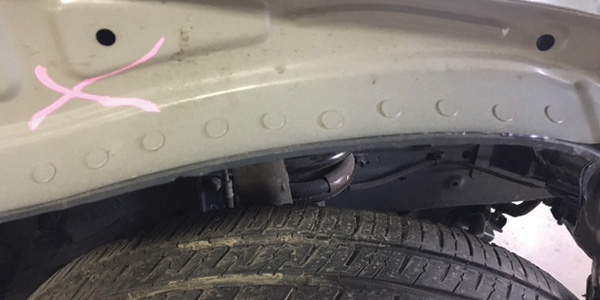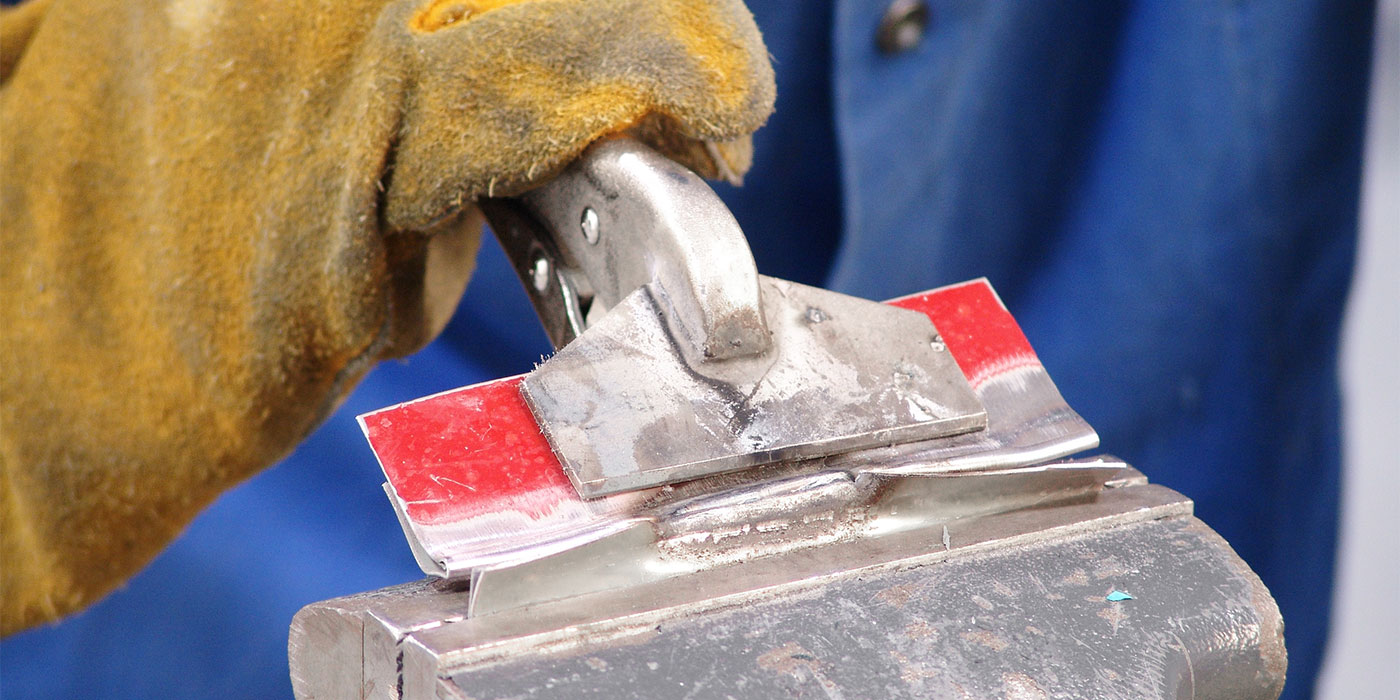
As this industry reacts to the electronic revolution of pre-scans, post-scans and recalibrations, changes in vehicle manufacturing keep marching on.
Change can be tough to deal with for many people. We all tend to get comfortable with the old ways of doing things. This comfort zone has been rattled by change in recent years – change in steels, welding and the introduction of mainstream aluminum vehicles. Now, let’s top it off with electronics that seem to test the limits of our imagination.
A good way to cope with change is knowing why the change happens. As we see more aluminum enter our industry, along with hybrid construction materials, we’ll see a lot more rivets being used. Self-piercing rivets (SPRs) were first used in Germany in the garage door industry, and now they’ve found their way into other industries, including automotive.
The Old Way Is the Wrong Way?
What’s wrong with the old way of doing things? That’s a great question. Being a techno nut and a nerd who likes to try to figure out why things work, I started reading about vehicle changes. Being an I-CAR instructor for 25-plus years also made me curious about the changes we’re seeing. It really comes down to the basics. Change in automobiles is being driven by specific needs and wants. We need better fuel economy. We want more power. We need longer-lasting vehicles. We want more recyclability. We want it all, but we don’t want to pay for it. So how do we do it all?
Convenience
For many years, convenience has driven the industry. Trying to keep it simple and cost-effective was the drive. Steel manufacturing and welding vehicles together made sense because it’s fast and produces a strong weld. The thickness of steels and corrosion protection practices made for long-lasting products.
When the drive for fuel economy changed manufacturing, steels were engineered to be much thinner and stronger. The mainstreaming of unibody vehicle construction took over in manufacturing. The use of squeeze-type resistance spot welding (STRSW) grew more popular. Spot welding was the solution for the need to weld and not add weight – important considering a vehicle will have between 3,000 to 5,000 welds per vehicle. The theory was that basically the weld was “free,” as you were not adding a part or weight to the process. Today’s new vehicles are still using spot welds, and that trend will still be around for a long time.
However, the old adage, “Nothing is free,” applies to spot welds too. The amount of energy required and the need to provide corrosion protection to the weld zone has a price. Processes are added to the manufacturing to give longevity to the vehicle. Another factor to spot welding price is that the fatigue failure rate of spot welds is high. Even though the damaging heat effect on the steel itself is reduced dramatically, a spot weld can change the mechanical properties of the steel. This is one reason why weld bonding became so important. The adhesive does three important things:
- It protects the weld from corrosion by sealing the weld joint.
- It adds strength to reduce fatigue failure, adding longevity to the weld.
- It seals the vehicle to NVH (noise, vibration, harshness) issues.
The list is actually longer, but know that the weld and adhesive complement each other’s weaknesses. In any welding, mechanical bonding or joining process, the adhesive will have a significant role.
Aluminum
Increasing pressure on manufacturers to reduce vehicle emissions and fuel consumption has brought us a wave of technical innovations. As mentioned before, we see so many changes in engines and electronics. The biggest factor to improving vehicles is weight. Since it has been shown that consumers will spend a little more on fuel-efficient vehicles, manufacturers are willing to move to more expensive aluminum. Add in plastics and composites and the weight starts coming off quickly.
Steel is ultimately stronger, but aluminum alloys being developed have certain advantages:
- Aluminum is 1/3 the weight of steel.
- Aluminum contributes to better body strength and lower weight.
- Aluminum is more corrosion-resistant.
- Aluminum can be combined with many other materials easily.
There are major differences, however, in the way aluminum is attached. To put it simply, the welding process for steel does not transfer to aluminum. The reasons we look to mechanical fastening are:
- Thermal conductivity is higher in aluminum, requiring different equipment.
- The oxide layer can weaken welds.
- The oxide layer protecting aluminum damages welding tips.
- The electrical power required is significantly higher than for steel due to high electrical conductivity.
GM has developed a way in which welding can overcome these issues. Until more is known or it becomes a more common process, we’ll still have these obstacles.
Mechanical Bonding
Mechanical joining is nothing new to the auto industry. Bolts, screws and rivets have been around for years. Most shops and technicians have a basic understanding of their use and application. With aluminum, there’s a focus on using slightly different processes. Since galvanic corrosion is a great concern, materials and how the aluminum is attached has to be well thought out. A great advantage to aluminum over STRSW is the ability to mechanically attach almost any other material. Through the use of bolts, flow drill screws, clinches or rivets, vehicle manufacturers are assembling a very durable vehicle.
Rivets
Rivets have been around for as long as any of us can remember. Unless you worked for a specialty aluminum shop, not many people knew what an SPR was when Ford introduced the F-150. Everyone went, “What is an SPR? And the gun to use them costs what?”
SPRs changed the way we looked at aluminum tremendously. How can a rivet be stronger than a weld? That comes back to reasons mentioned earlier. A weld on aluminum may not be as strong as you think. The heat from welds changes the mechanical properties. Also, oxides contaminate the area. A rivet has few damage issues when used as no heat is applied. Advantages include:
- No heat, therefore no damage to the mechanical properties of metal
- No corrosion issues
- No plating or coating may be needed after application
- Can be applied very quickly in manufacturing – one every 1.6 seconds, according to Henrob Inc.
- Single-step operation
- No pre-drilling
- Visually appealing
- Very low fail rate from fatigue
- Can be duplicated in repairs
- Can be used on aluminum and steel
Along with forming an airtight and watertight seal on almost any thickness and material strength, SPRs have advantages that overcome the slight weight gain they cause. It’s a low-energy bonding that creates no fumes or chemicals and bonds multiple materials. Because there are few moving parts and the ease and speed they provide in the assembly process, SPRs are gaining in popularity in all facets.
SPR
What is an SPR? A semi-tubular shape rivet. In many cases in automotive, they’re coated steel to prevent galvanic corrosion. As pressure is applied, the rivet pierces the top layer of the metal. As the rivet is pushed into the die on the other side, significant forces shape the tube and flares the tube out inside the second layer, forming a clinched mechanical joint. Unlike a blind rivet or solid rivet, there is no piercing through of the second layer. A bucktail is formed from the metal stretching over as the flare is made.
SPRs come in different sizes for different applications. No matter which size, the application is the same. To use an SPR, a specialized press or press gun must be used.
Significant force is required to use these rivets. Some can be very expensive, depending on what type of vehicle you’re working on. A major concern in the use of SPRs is access for the tool or gun to both sides. There is no one-sided application. Where this does become a problem, a blind rivet may be used to complete the bond joint.
Clinch Rivet
A variation of the SPR is the clinch rivet. The operation is similar, with a dramatic difference. The rivet does not pierce the top layer but presses both layers of metal down to form a bucktail, flaring the top layer into the lower. This has proven to add significant strength to thinner metals. Work hardening the top layer around the rivet as it’s being pressed offers tremendous tensile and lap shear strength – the strength that adhesives used in the SPR process provides.
Let me clarify one thing: SPRs work the same in aluminum and steel. Piercing the second layer defeats the purpose of the rivet. If this is occurring, you have the wrong rivet for that application. Or, the setup is wrong. A general rule of thumb is the rivet will pierce the top or thinner layer metal and flare in thicker or lower. If panels are the same thickness, the proper part number of rivet is crucial to a successful bond joint.
Blind Rivets
Blind rivets would be applied if a hole is present in both panels or if there’s limited access to both sides. Although they look different, their use is similar. This is where a repair may not look the same as the original from the factory, but the repair and integrity are correct. It’s an appearance issue. The big difference is the rivet itself pulls panels together, where an SPR presses.
Solid Rivets
Although seemingly a lost art, solid rivets are a great alternative to SPRs. A hole is drilled and tapered to a shoulder of 100deg. As the solid rivet head is the same, this will form a flush bond on one side. The back of this application will leave a bucktail. Although it looks good from one side, the back side will be visibly raised and noticeable, which could cause sight problems or the need to attach gaskets. This process also requires access to both sides to perform. If access to both sides is available, SPRs are best. If the arms don’t reach, adapters may be needed if available. If not, then you need to find an alternative.
Adhesives
I don’t know of an application in which rivets, whether SPR or blind, are being used where adhesive is not required. However, there may be some I don’t know of. The proper adhesive and bond line thickness is a major part of the mechanical joint. Adhesives seal joints and add strength to prevent fatigue of those joints. Using the correct adhesive ensures a proper strength bond. Be sure to read vehicle manufacturers’ guidelines on which adhesive to use and application instructions. I-CAR has hands-on training on this subject available today.













